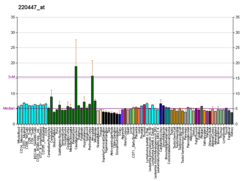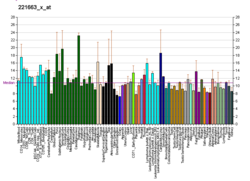Histamine H3 receptors are expressed in the central nervous system and to a lesser extent the peripheral nervous system, where they act as autoreceptors in presynaptic histaminergic neurons and control histamine turnover by feedback inhibition of histamine synthesis and release.[5] The H3 receptor has also been shown to presynaptically inhibit the release of a number of other neurotransmitters (i.e. it acts as an inhibitory heteroreceptor) including, but probably not limited to dopamine, GABA, acetylcholine, noradrenaline, histamine and serotonin.
The gene sequence for H3 receptors expresses only about 22% and 20% homology with both H1 and H2 receptors respectively.
There is much interest in the histamine H3 receptor as a potential therapeutic target because of its involvement in the neuronal mechanism behind many cognitive disorders and especially its location in the central nervous system.[6][7]
- ^ a b c GRCh38: Ensembl release 89: ENSG00000101180 – Ensembl, May 2017
- ^ a b c GRCm38: Ensembl release 89: ENSMUSG00000039059 – Ensembl, May 2017
- ^ "Human PubMed Reference:". National Center for Biotechnology Information, U.S. National Library of Medicine.
- ^ "Mouse PubMed Reference:". National Center for Biotechnology Information, U.S. National Library of Medicine.
- ^ West RE, Zweig A, Shih NY, Siegel MI, Egan RW, Clark MA (Nov 1990). "Identification of two H3-histamine receptor subtypes" (abstract). Molecular Pharmacology. 38 (5): 610–3. PMID 2172771.
- ^ Rapanelli, Maximiliano. “The Magnificent Two: Histamine and the H3 Receptor as Key Modulators of Striatal Circuitry.” Progress in Neuro-Psychopharmacology and Biological Psychiatry 73 (February 2017): 36–40
- ^ Cite error: The named reference
:0was invoked but never defined (see the help page).





